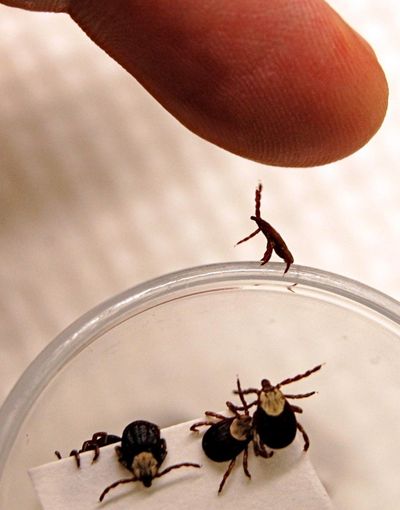The tick-friendly Northwest

As the Palouse shrugs off the last gasps of winter weather, pedestrians and pet owners may have noticed an explosion of activity among that pernicious perennial parasite – the tick.
This year’s tick season may seem more active than most, but experts say these large numbers may have more to do with swarms of the bug awakening all at once rather than an appreciable rise in local tick populations. Cassandra Olds, a postdoctoral candidate at the University of Idaho who spent 10 years studying ticks and tick-borne illnesses, said the tiny arachnid does not produce its own body heat and so must rely on warm weather to become active in the spring.
“The moment it warms up, they start sort of waking up and coming out to look for food, which is us and other mammals and animals, and so they just became very active very quickly,” Olds said. “We saw a sort of rapid explosion of everybody waking up at the same time. That’s why people have been saying there’s so many ticks this year, but we might see these numbers sort of dip off.”
It can take as long as three years for a larval tick to mature into an adult, Olds said, making it difficult for experts to forecast just how strong their numbers will be in a given year. They must consider the climatological conditions of the current season and of the preceding seasons as well. She said this is further complicated as climate change warps the range and distribution of different tick species, causing them to migrate to regions they did not previously occupy.
“We’ve already seen changes in populations and this is concerning, because these ticks, they carry diseases with them,” Olds said. “So we’re seeing changes in the distribution not only of ticks but of the diseases that they transmit.”
According to the Centers for Disease Control and Prevention, reported cases of spotted fever, Lyme disease and other tick-borne maladies jumped from around 48,500 in 2016 to nearly 60,000 in 2017. Fortunately for residents in the Pacific Northwest, the most common tick in the region – the Rocky Mountain wood tick – prefers deer and livestock to human hosts. And while they are an ideal vector for illnesses like Rocky Mountain spotted fever, Olds said it is pretty rare for a human to contract a disease from a tick bite.
Olds said the rise in reported cases of tick-borne maladies might be partially because of an overall rise of tick numbers, but it is important to consider other factors as well. She said diagnostic procedures have become better at detecting these illnesses and increased access to health care could result in a rise in reported cases as well. However, she said, it is often the case that climate change promotes an environment that is more tick-friendly and as populations swell, it is reasonable to expect instances of tick-related illness to rise as well.
“Ticks have been around for 120 million years, they’re kind of good at what they are, so tick behavior itself isn’t changing. They still follow pretty much the same cycles as they always have,” Olds said. “It’s more just that human life has impacted the world in such a way that it’s making it a nicer environment for ticks to live in, so we’re going to get more of them over time and their distribution patterns are going to change.”